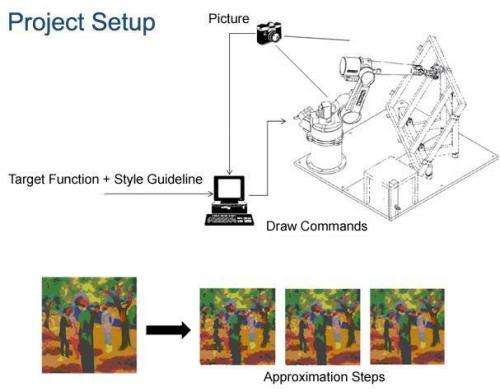July 15, 2013 report
Calculating art: Meet e-David, the painting machine (w/ Video)

(Phys.org) —Sometime in the future, you will be at an art gallery where you are drawn to a nice-looking tree, or haunting line drawing of a woman's face, or historical portrait, and you will wonder who is the artist. Eye the lower corner of the canvas and it will tell you, "David." What you might not realize is that David is a robot—e-David, to be exact. A team at the University of Konstanz in Germany have developed e-David as a robot "artist" that uses software to decide where to add the next brush stroke. After each brush stroke, e-David takes a picture, and its software calculates such moves as where the image needs to be lightened or darkened. At the University of Konstanz, the group said their project objective is to build a robot that can paint, pure and simple. By paint, they do not mean adding a fresh coat to a kitchen ceiling but delivering art.
The school's Department of Computer and Information Science has a structure where workgroups share a common research topic, and e-David is a project within the topic, "Exploration and visualization of large information spaces."
The robot is not "person-able," more like the metallic skeleton of a mythical and very studious canine. They used an industry robot normally used to weld car bodies, and enhanced it with sensors, camera, control computer, and art supplies. They chose the name "David" not because they especially liked that name but because it stands for what they tried to accomplish: Drawing Apparatus for Vivid Image Display.
The computer program provides drawing commands that are executed by the machine. This can be considered as a step above humans painting- by-numbers: Just as one observes sidewalk artists repeatedly tweaking their lines and dabs and brush strokes as they fill an empty canvas, the robot does something similar. The device takes a picture of what it wants to copy. The robot watches itself paint and decides where to add the next stroke, constantly tweaking its moves based on what it's seeing through a camera pointed at its canvas.
"We establish a control loop using the camera in which the output of the robot is captured and new drawing commands are computed that correct the errors of the preceding step." As for art supplies, the team provides a generous outlay of five different brushes and 24 colors.
The machine's output raises the question of whether a machine can actually achieve works of artistic merit.
Isn't a good painting or line drawing by a human artist more than just a set of rules? How far are we going in expecting a system capable of "algorithms for spatial division" and "color and content composition" to result in comparable works of art?
Continued exploration with e-David could provide some interesting insights. "Our hypothesis is that painting – at least the technical part of painting – can be seen as optimization processes in which color is manually distributed on a canvas until the painter is able to recognize the content." They said that e-David "will enable us to enclose the whole process of drawing production into an optimization framework. This will allow us to investigate human optimization schemes and to find out to what extent such schemes can be formulated using algorithms."
It need not be a question of a future Picasso versus an e-David but rather an advantageous collaboration of artist with machine, one where the machine enables new techniques for artists.
More information: www.informatik.uni-konstanz.de/en/edavid/
© 2013 Phys.org




















